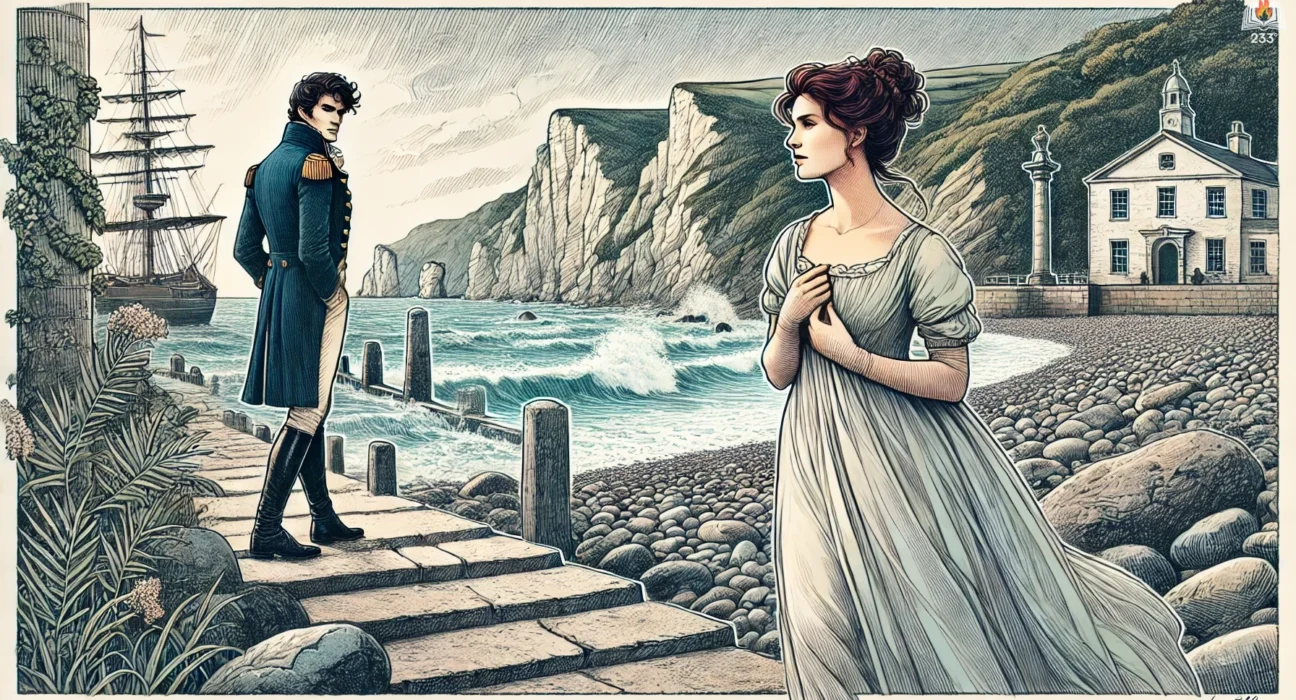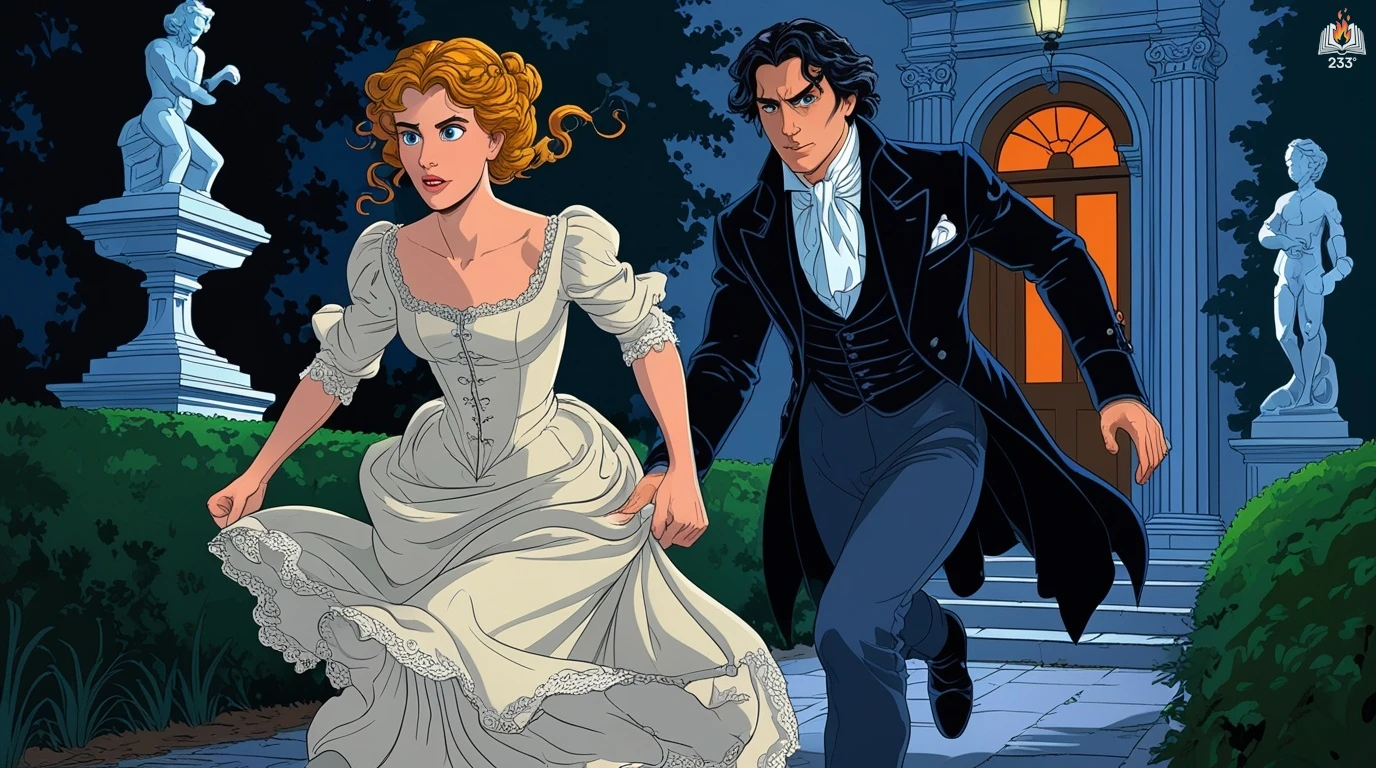Persuasion is the final completed novel by Jane Austen, published posthumously in 1818. The novel explores the themes of love, regret, and second chances, centering on the life of Anne Elliot, a young woman who, years earlier, had been persuaded to reject the man she loved due to his lack of wealth and social standing. Set during the early 19th century, the story offers a critique of the class system and the limited roles available to women, while also offering a heartfelt narrative about lost love and personal growth. Written in Austen’s distinctive style, Persuasion combines sharp social commentary with a tender, introspective tone, making it one of her most mature and emotionally resonant works.
Plot Summary
Anne Elliot sat in the quiet of Kellynch Hall, the family estate she loved, though it no longer felt like home. At twenty-seven, she had lived much of her life in the shadow of her father’s vanity and her elder sister’s self-importance. Sir Walter Elliot, her father, was more concerned with his appearance and social standing than the mounting debts that threatened their family’s position. And Elizabeth, her eldest sister, was much like him—focused only on prestige and the hope of a grand marriage. Anne, once beautiful in her youth, had grown quieter and thinner, unnoticed by her family, though her mind and heart were still rich with feeling.
Eight years before, Anne had been engaged to Frederick Wentworth, a young naval officer with little fortune but much ambition. Though deeply in love, Anne had been persuaded by Lady Russell, her late mother’s closest friend, to break off the engagement. Wentworth’s uncertain prospects and lack of status had been deemed unsuitable for a girl of Anne’s birth. Lady Russell had urged caution, and Anne, trusting in her judgment, had reluctantly ended the engagement, breaking her own heart in the process. Wentworth left Somerset, wounded and disappointed, and Anne resigned herself to a life of quiet regret.
Now, years later, Kellynch Hall was to be rented out to cover Sir Walter’s debts, and the family would relocate to Bath. Anne, though saddened by the thought of leaving her childhood home, accepted her fate with the calm dignity she had always shown. The tenants for the estate would be Admiral and Mrs. Croft—respectable people, and, as it happened, the brother-in-law and sister of Frederick Wentworth. Though she hadn’t seen him in nearly a decade, the prospect of his return stirred old memories. Anne wondered if time had softened his anger, but she feared that he would remember her only as the woman who had rejected him.
Anne’s younger sister, Mary, now married to Charles Musgrove of Uppercross, invited her to stay at the Musgroves’ cottage. Anne, eager for escape from her family’s pressures, accepted. The Musgrove household was full of life and noise, a welcome change from the quiet melancholy of Kellynch. There, she found herself mingling with the Musgrove sisters, Henrietta and Louisa, who were lively and affectionate. Soon after, news arrived that Captain Wentworth had returned to the area. He was now wealthy, having achieved great success in the Navy, and was once again a bachelor. The Musgroves, who knew nothing of Anne’s past with him, warmly welcomed him into their circle, and Anne’s heart trembled at the thought of seeing him again.
When they finally met, it was clear that Wentworth had not forgiven her. Though he was polite, his manner toward Anne was cool and distant, and she was forced to watch as he charmed the Musgrove sisters. His attentions were particularly focused on Louisa, a young woman of exuberant spirit. Anne felt her heart ache as she saw the man she had once loved so deeply appear to court another.
Captain Wentworth, however, was not immune to Anne’s presence. Despite his outward indifference, he could not help but notice how she had matured, how her calmness and grace stood in contrast to the frivolous girls around him. Still, his pride and the pain of their past kept him distant, and he began to show more serious interest in Louisa, to the delight of the Musgroves.
The tension between Anne and Wentworth reached its peak during a trip to Lyme, where they visited Captain Wentworth’s friends, Captain Harville and Captain Benwick. The seaside town brought Anne unexpected solace, and she found a quiet companionship with Captain Benwick, who, like her, was nursing the wounds of lost love. He had recently lost his fiancée and found comfort in books and conversation with Anne. Though they were kindred spirits, Anne’s heart remained bound to the past.
During this visit, tragedy struck. Louisa, in her exuberance, attempted to leap from a flight of stairs into Wentworth’s arms but misjudged the jump and fell, seriously injuring herself. The accident was a turning point for Captain Wentworth. In the aftermath, he realized that Louisa’s reckless spirit, which had once entertained him, was not what he truly valued. His admiration for Anne’s steadiness and strength resurfaced, but he believed he had lost her forever. Anne, for her part, attended to Louisa with quiet efficiency, further impressing Wentworth, though she believed their chance for happiness had passed.
Back in Bath, where her family had now settled, Anne found herself the object of renewed interest from Mr. William Elliot, her cousin and the heir to Kellynch Hall. After years of estrangement, he reentered their lives, charming Sir Walter and Elizabeth. He soon began to court Anne, who was flattered but cautious of his intentions. Lady Russell, who had once guided Anne away from Wentworth, now encouraged this new match, seeing in Mr. Elliot the security and status she believed Anne deserved.
But Anne’s heart remained conflicted. Despite Mr. Elliot’s attentions, she could not forget Wentworth. When he came to Bath, their paths crossed again. A chance conversation between Anne and Captain Harville revealed to Wentworth that Anne had never stopped loving him. Overhearing her speak of constancy in love, he realized that she still cared for him as deeply as ever.
In a passionate letter, Wentworth confessed his feelings to Anne, telling her that his heart had always been hers. The letter, filled with tenderness and longing, rekindled the flame that had never truly been extinguished. Anne, overwhelmed with joy, responded to his feelings, and their reunion was tender and emotional, a culmination of years of regret and unspoken love.
Anne and Wentworth’s second chance at happiness was a testament to the strength of their love. While the world around them had changed, their feelings had remained steadfast. Anne, no longer swayed by the opinions of others, embraced the future with the man she had always loved, and Captain Wentworth, now wealthy and successful, found his greatest happiness not in his achievements but in his reunion with Anne.
Together, they looked forward to a life built on the foundation of mutual respect, shared values, and enduring love.
Main Characters
Anne Elliot: The protagonist of the novel, Anne is a thoughtful and intelligent woman who was persuaded to break off her engagement with Frederick Wentworth eight years earlier. At 27, she is unmarried and often overlooked by her family. Despite her quiet demeanor, Anne has deep feelings and is highly principled. Over the course of the novel, she matures into someone who is willing to assert her own desires.
Captain Frederick Wentworth: Anne’s former fiancé, who reenters her life after achieving success in the Navy. Once rejected by Anne because of his lack of fortune, he is now wealthy and respected. Throughout the novel, he struggles with his lingering feelings for Anne and the pain of their past.
Sir Walter Elliot: Anne’s vain and shallow father, a baronet more concerned with his appearance and status than with his financial problems. His irresponsibility with money is a key factor in the family’s declining fortunes.
Elizabeth Elliot: Anne’s older sister, who shares their father’s vanity and ambition. Elizabeth is dismissive of Anne and focused on maintaining her own social status, hoping to make a “good” marriage.
Lady Russell: A close friend of Anne’s deceased mother and a surrogate mother to Anne. She is the one who persuaded Anne to break off her engagement to Wentworth years ago. Lady Russell values social propriety and has a strong influence over Anne.
William Elliot: The cousin and heir to Sir Walter’s estate. He presents himself as a charming and eligible suitor for Anne but harbors ulterior motives that make his character ambiguous and duplicitous.
Mary Musgrove: Anne’s younger sister, married to Charles Musgrove. She is self-absorbed and often dramatic, frequently seeking attention for her supposed illnesses.
Captain Harville and Captain Benwick: Friends of Captain Wentworth from the Navy. Harville is loyal and steadfast, while Benwick, mourning the loss of his fiancée, shares a deep bond with Anne over their mutual love for literature.
Theme
Persuasion and Regret: The theme of persuasion is central to the novel, embodied in Anne’s initial decision to reject Wentworth due to external pressures. Throughout the book, Austen explores the consequences of allowing oneself to be swayed by others’ opinions and the regret that can follow when one’s true desires are ignored.
Second Chances: Both Anne and Wentworth are given a second chance at love, reflecting the broader theme of renewal. Their journey to rekindle their relationship illustrates the idea that love can be revived after hardship and time, if both parties have matured.
Social Class and Mobility: Austen critiques the rigid class structures of her time, especially through the character of Sir Walter, who clings to his title while his fortunes decline. Captain Wentworth’s rise through the Navy, despite his humble beginnings, represents a challenge to the entrenched social order, where merit can be more important than birth.
The Role of Women: Anne’s quiet suffering highlights the limited opportunities for women in 19th-century society. Without financial independence, women like Anne must navigate a world where marriage and social standing determine their worth. Austen’s portrayal of strong, intelligent women like Anne contrasts with the more superficial characters like Elizabeth and Mary, offering a subtle critique of gender expectations.
Nature and the Sea: The motif of the sea recurs throughout the novel, symbolizing freedom, adventure, and change. It is through his naval career that Captain Wentworth gains fortune and respect, and it represents the possibility of transformation and social mobility.
Writing Style and Tone
Jane Austen’s writing in Persuasion is marked by her trademark wit, irony, and social commentary, though the tone of the novel is notably more reflective and subdued than some of her earlier works. The narration is often filtered through Anne’s introspective perspective, offering a deeper, more nuanced exploration of emotion and internal conflict. Austen uses free indirect discourse to merge Anne’s thoughts with the narrator’s voice, creating a closeness between the reader and the protagonist.
The tone of Persuasion is tinged with melancholy and nostalgia, as the novel deals heavily with themes of lost time and regret. However, it is also hopeful, offering the possibility of redemption and the healing power of time. Austen’s language is elegant and precise, capturing the subtleties of social interaction and the unspoken tensions between characters. The restrained emotion of the prose mirrors Anne’s own reserved nature, and Austen’s sharp irony often critiques the vanity and absurdity of the upper class, especially through characters like Sir Walter and Elizabeth Elliot.
We hope this summary has sparked your interest and would appreciate you following Celsius 233 on social media:
There’s a treasure trove of other fascinating book summaries waiting for you. Check out our collection of stories that inspire, thrill, and provoke thought, just like this one by checking out the Book Shelf or the Library
Remember, while our summaries capture the essence, they can never replace the full experience of reading the book. If this summary intrigued you, consider diving into the complete story – buy the book and immerse yourself in the author’s original work.
If you want to request a book summary, click here.
When Saurabh is not working/watching football/reading books/traveling, you can reach him via Twitter/X, LinkedIn, or Threads
Restart reading!








